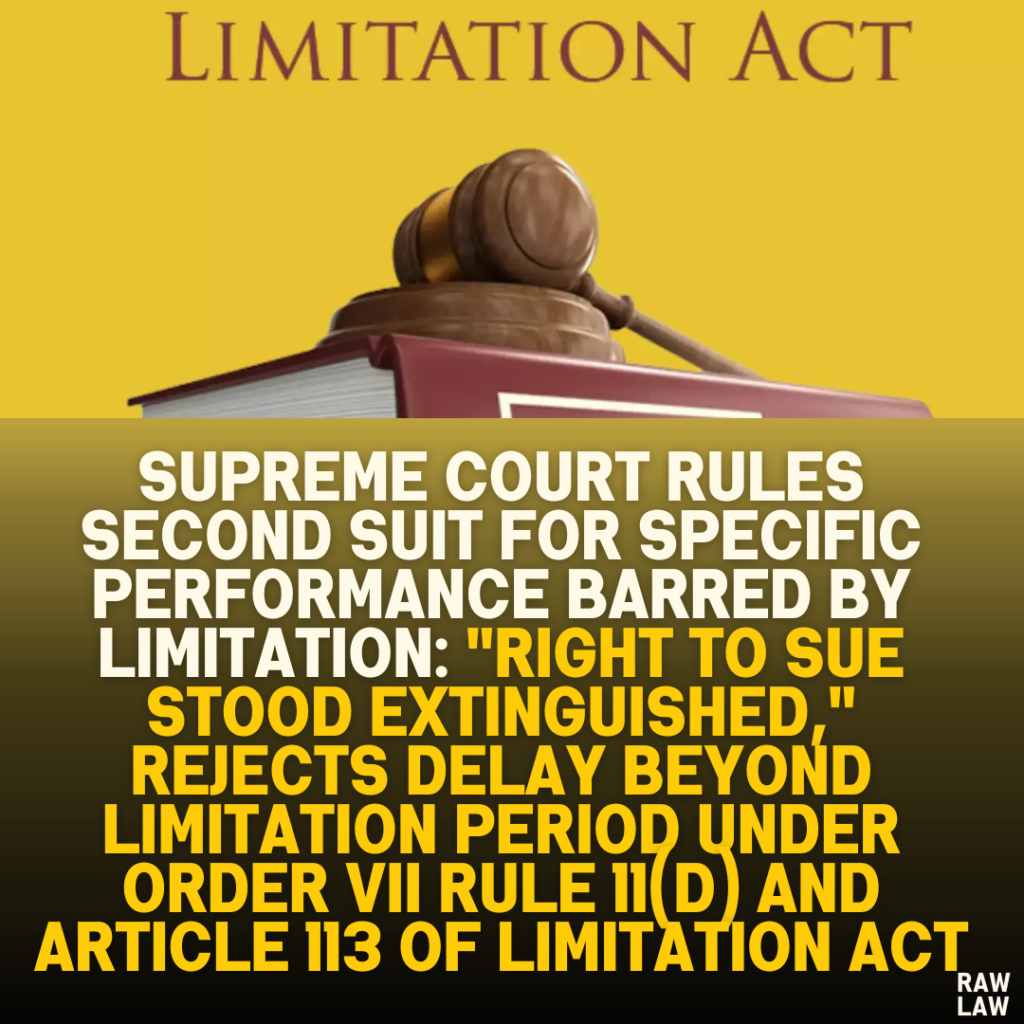Court’s Decision:
The Supreme Court overturned the decisions of the Madras High Court and the trial court, ruling that the second suit filed in 2007 for specific performance was barred under Order VII Rule 11(d) of the Code of Civil Procedure, 1908, and Article 113 of the Limitation Act, 1963. The Court held that the limitation period for filing the suit had expired, and the second suit could not be maintained.
Facts:
- Background of the Property:
- The case involved a property dispute over 5.05 acres of land in Kodaikanal, which was part of a larger 6.48-acre property originally purchased in 1912.
- In 1991, the appellant (trust) agreed to sell a part of the land to the respondent (buyer) for ₹3.02 crore, with an advance payment of ₹10 lakh. The buyer was given partial possession.
- Litigation History:
- The respondent first filed a suit for specific performance in 1993 to enforce the agreement.
- This suit was rejected in 1998 by the trial court due to the respondent’s failure to pay the required court fees.
- A second suit for the same relief was filed in 2007 by the respondent, claiming that litigation delays and an extension letter had kept the cause of action alive.
- Key Arguments:
- The appellant argued that the second suit was filed well beyond the three-year limitation period prescribed by law and should be rejected.
- The respondent claimed that an extension letter dated July 15, 1991, had postponed the timeline for performance and that ongoing litigation with third parties caused delays.
Issues:
- Whether the second suit filed in 2007 was barred by limitation under Order VII Rule 11(d) of the Code of Civil Procedure, 1908.
- Whether the respondent could rely on the alleged extension letter to justify the delayed filing.
Petitioner’s (Appellant’s) Arguments:
- Limitation Period Expired:
- The initial cause of action arose in 1993, and the rejection of the earlier suit in 1998 extended the limitation period by three years (i.e., until 2001). Filing the second suit in 2007 was therefore time-barred.
- Inconsistent Claims:
- The respondent’s reliance on the alleged letter of July 15, 1991, was an afterthought. This letter was not mentioned in the first suit, raising doubts about its authenticity.
- Delay Without Reason:
- The respondent’s actions showed negligence, as no valid explanation was provided for the nine-year delay in filing the second suit.
Respondent’s (Buyer’s) Arguments:
- Fresh Suit Permitted:
- Under Order VII Rule 13, the rejection of a plaint does not bar the filing of a fresh suit based on the same cause of action.
- Extension Letter:
- The letter dated July 15, 1991, extended the time for performance of the agreement, as multiple litigations between the parties and third parties delayed the execution of the sale.
- Mixed Question of Fact and Law:
- The respondent argued that whether the suit was barred by limitation could only be determined after evidence was recorded.
Analysis of the Law:
- Order VII Rule 11(d) – Rejection of Plaint:
- This rule allows the rejection of a plaint if, from its statements, the suit is barred by any law, including limitation laws.
- Limitation Act, 1963:
- Article 54: Specific performance suits must be filed within three years from the date fixed for performance or, if no such date is fixed, when the plaintiff has notice that performance is refused.
- Article 113 (Residuary Article): Provides a three-year limitation period for suits not covered under other articles, commencing from the date the right to sue accrues.
- Supreme Court’s Findings:
- The respondent’s first suit was filed in 1993 and rejected in 1998 for non-payment of court fees. The second suit, filed in 2007, was well beyond the limitation period of three years from the rejection of the earlier suit.
- The alleged extension letter dated July 15, 1991, was not mentioned in the first suit, making its introduction in the second suit suspect.
- The Court observed that the second suit appeared to be a speculative attempt to prolong litigation and gain an undue advantage.
Precedent Analysis:
The Court referred to past judgments to support its reasoning:
- T. Arivandandam v. T.V. Satyapal (1977): Courts must reject plaints that fail to disclose a clear right to sue.
- Biswanath Banik v. Sulanga Bose (2022): Courts should examine plaint averments holistically to determine if limitation laws apply.
- Delhi Wakf Board v. Jagdish Kumar Narang (1997): Fresh suits can be filed under Order VII Rule 13, but they must comply with limitation laws.
Court’s Reasoning:
- Inconsistent Pleadings:
- The respondent’s reliance on the extension letter was inconsistent with the facts presented in the earlier suit.
- If the letter truly extended the time for performance, the first suit in 1993 would have been premature.
- Lack of Diligence:
- The respondent’s delay in filing the second suit showed a lack of readiness and willingness to perform the contract.
- Bar Under Limitation Act:
- The second suit was barred under Article 113 of the Limitation Act, as the right to sue had extinguished by 2001.
Conclusion:
The Supreme Court allowed the appeal, rejecting the plaint in the second suit. The Court held:
“Once the time to sue has begun, it runs continuously unless stopped by express statutory provision. The right to sue stood extinguished.”
Implications:
- Adherence to Limitation Periods:
- The judgment reinforces the importance of filing suits within prescribed time limits to avoid dismissal.
- Consistency in Pleadings:
- Parties must ensure their claims are consistent across proceedings to avoid suspicion.
- Discouragement of Speculative Litigation:
- The decision discourages litigants from using procedural loopholes to prolong disputes.
